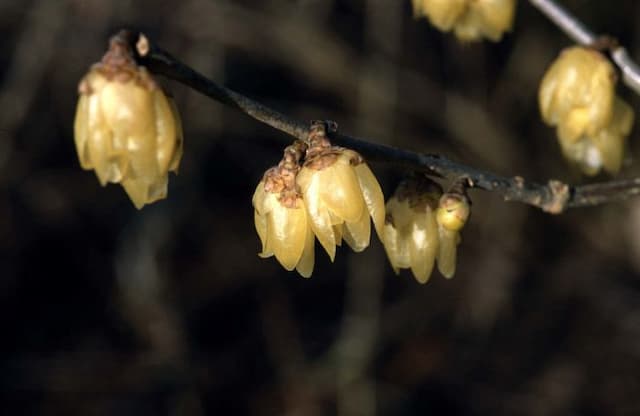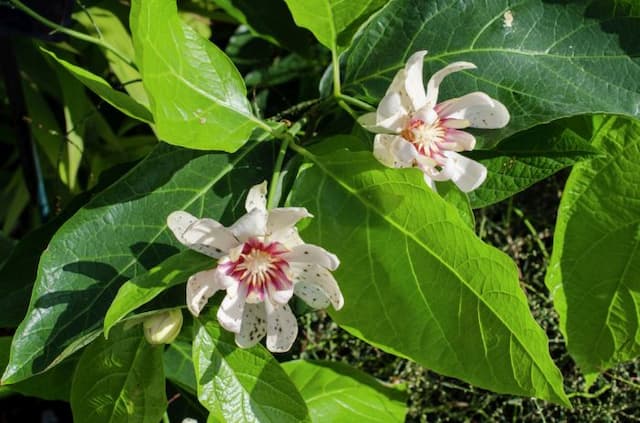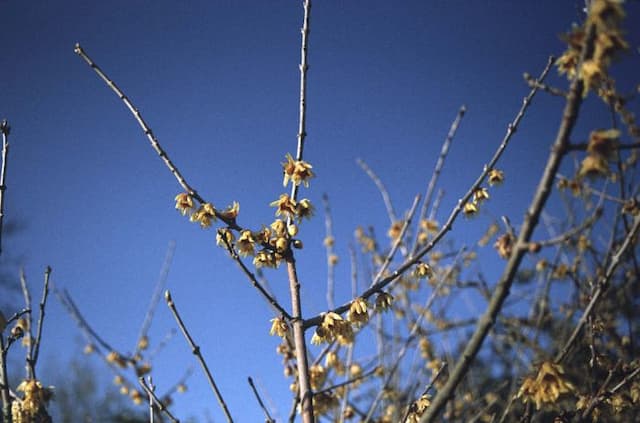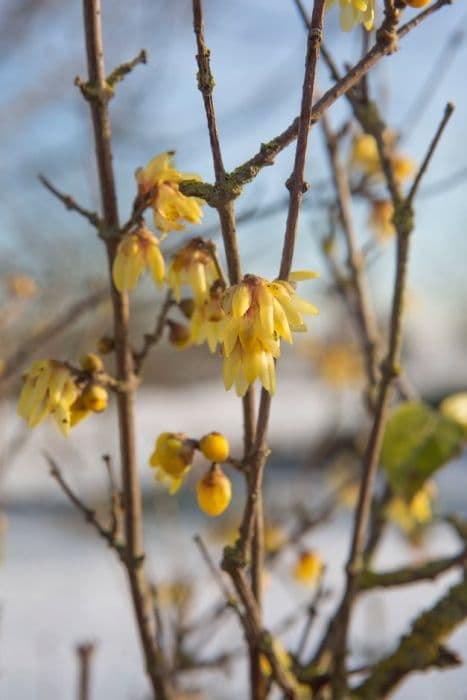Raulston's Allspice Calycanthus × raulstonii 'Hartlage Wine'

ABOUT
The 'Hartlage Wine' is a hybrid of the Sweetshrub notable for its ornamental features. It possesses a multi-stemmed shrub form that creates an alluring presence in gardens. The leaves are broad and deciduous, emerging in a vibrant green that serves as a beautiful backdrop to its blossoms. The true standout feature of this plant is its remarkable flowers. They boast rich, wine-red to dark maroon petals, which form an intricate, multi-layered star shape. The center of each bloom is adorned with a cluster of small, pale yellow, inner petals and stamens that contrast strikingly with the darker outer petals. These flowers emit a light, yet enchanting fragrance similar to that of ripening apples, which adds to the sensory appeal of the plant. After blooming, which typically occurs from late spring to early summer, the flowers give way to urn-shaped fruits, although these are not often considered a significant ornamental feature. Throughout the growing seasons, the 'Hartlage Wine' maintains a lush and full appearance with its glossy green foliage, which can turn to yellows and bronzes in the autumn before falling off for the winter. This plant is well-regarded for its distinctive flowering, scent, and overall contribution to the aesthetic of a garden space.
About this plant
 Names
NamesFamily
Calycanthaceae
Synonyms
Raulston's Allspice, Hartlage Wine Sweetshrub, Hybrid Sweetshrub
Common names
Calycanthus × raulstonii 'Hartlage Wine'.
 Toxicity
ToxicityTo humans
The plant commonly known as 'Hartlage Wine' sweetshrub generally is not considered highly toxic to humans. However, as with many plants, it may cause mild gastrointestinal discomfort if ingested. The main concern would likely be from the accidental ingestion of plant parts by curious children or pets, which might result in symptoms such as nausea, vomiting, or diarrhea. Ingesting large quantities could potentially lead to more serious gastrointestinal upset. If ingestion occurs and symptoms present, it is advisable to consult with a medical professional.
To pets
The 'Hartlage Wine' sweetshrub is not commonly known to be highly toxic to pets, but it still may pose a risk if ingested. Pets, particularly dogs and cats, might experience mild gastrointestinal upset with symptoms such as vomiting or diarrhea if they consume parts of the plant. While it is not considered to be severely poisonous, monitoring your pet for any unusual behavior after ingestion is recommended. If your pet appears to be in distress or if symptoms persist, contacting a veterinarian for advice would be prudent.
 Characteristics
CharacteristicsLife cycle
Perennials
Foliage type
Deciduous
Color of leaves
Green
Flower color
Red
Height
8-10 feet (2.4-3.0 meters)
Spread
6-8 feet (1.8-2.4 meters)
Plant type
Shrub
Hardiness zones
5-9
Native area
Southeastern United States
Benefits
 General Benefits
General Benefits- Ornamental Value: Calycanthus 'Hartlage Wine' is known for its striking, wine-red flowers which can add aesthetic appeal to gardens.
- Seasonal Interest: This plant provides season-long interest with its blooms in spring and summer, and attractive foliage during other seasons.
- Wildlife Attraction: The flowers can attract pollinators such as bees and butterflies, promoting biodiversity in the garden.
- Low Maintenance: 'Hartlage Wine' is considered easy to care for, requiring minimal pruning and adaptable to various soil conditions.
- Drought Tolerance: Once established, it can tolerate periods of drought, making it suitable for gardens with water restrictions.
- Hardiness: It is known for being hardy and can survive in cold temperatures, making it suitable for a range of climates.
- Non-Invasive: This hybrid variety does not typically spread beyond its planting area, making it a good choice for controlled landscaping.
- Deciduous Nature: As a deciduous shrub, it can provide a dynamic change in the landscape as seasons change.
 Medical Properties
Medical PropertiesThis plant is not used for medical purposes.
 Air-purifying Qualities
Air-purifying QualitiesThis plant is not specifically known for air purifying qualities.
 Other Uses
Other Uses- Privacy Screening: The dense, large leaves of the Sweetshrub 'Hartlage Wine' can be used to create an attractive privacy screen in residential areas.
- Wildlife Habitat: Provides shelter and nesting sites for birds and other small wildlife within a garden setting due to its branching structure.
- Foundation Planting: Due to its hardiness and moderate size, it can be used as a foundation plant to enhance the architectural features of buildings.
- Natural Dyes: Flowers or bark may be used to create natural dyes for fabrics, though this is less common and would require experimentation for colorfastness.
- Photography Backdrop: The striking flowers and foliage provide a beautiful backdrop for photographers, particularly in spring when the plant is in bloom.
- Educational Tool: Could be used in schools or educational gardens to teach about plant hybridization and breeding, as 'Hartlage Wine' is a hybrid plant.
- Scented Garden Addition: The fragrance can contribute to a scented garden concept, designed for enjoyment through olfactory experiences.
- Garden Sculpture Incorporation: Garden designers can integrate the plant as a living element in combination with garden sculptures, emphasizing the artistic aspect of garden design.
- Cut Branches for Indoor Decoration: Branches with leaves and flowers may be cut and brought indoors for temporary natural decorations, or used in floral arrangements.
- Seasonal Interest in Mixed Borders: Its early bloom time adds a burst of color in mixed borders or perennial beds before many other plants have started flowering.
Interesting Facts
 Feng Shui
Feng ShuiThe plant Raulston's allspice is not used in Feng Shui practice.
 Zodiac Sign Compitability
Zodiac Sign CompitabilityThe plant Raulston's allspice is not used in astrology practice.
 Plant Symbolism
Plant Symbolism- Rarity: As a hybrid plant, the Hartlage Wine, also known as the "Raulston's Sweetshrub," embodies the concept of rarity and uniqueness, symbolizing how precious and uncommon certain attributes or individuals are in our lives.
- Mystery: With its unusual maroon-red flowers and spicy-sweet fragrance, the Hartlage Wine represents mystery and the unknown, reminding us of nature's hidden secrets and the allure of exploring the unexplored.
- Attraction: The rich, wine-colored blooms and captivating scent of the Hartlage Wine symbolize attraction and charm, signifying the magnetic pull between beings or the enticement of sensory pleasures.
- Beauty: The unique and aesthetically pleasing appearance of the Hartlage Wine's flowers symbolizes beauty and grace, celebrating the visual and sensory delights that life has to offer.
- Love: Often associated with passion due to its color and fragrance, the Hartlage Wine can symbolize deep love and affection, much like how a fine wine can enhance romantic feelings.
 Water
WaterThe Raulston Allspice 'Hartlage Wine', commonly known as the Raulston Allspice, requires consistent moisture, particularly in its first few growing seasons to establish a deep, extensive root system. Once established, it's more drought-tolerant. During the first season, water regularly to keep soil uniformly moist but not soggy. An approximate guideline is 1 inch of water per week, either through rainfall or manual watering. In the absence of rain, this would translate to about 0.5 gallons for a small shrub, increased proportionally for larger plants. Reduce frequency in fall before the first frost, to encourage hardiness.
 Light
LightRaulston Allspice 'Hartlage Wine' thrives in full sun to partial shade. The ideal location would offer morning sunlight and afternoon shade, especially in hotter climates. However, it is versatile and can perform well in a spot that receives sun for most of the day. Avoid deep shade locations as this will reduce the plant's vigor and flowering potential.
 Temperature
TemperatureRaulston Allspice 'Hartlage Wine' does best in moderate conditions and can generally tolerate a temperature range from as low as 0°F to as high as 100°F. However, the ideal growing temperatures for this plant are between 60°F and 80°F. Protection from extreme winter temperatures may be necessary to prevent damage to the plant.
 Pruning
PruningPruning of Raulston Allspice 'Hartlage Wine' should be done to maintain shape and promote healthy growth. Pruning is best performed after flowering to avoid cutting off any of next season's blooms – typically late spring or early summer. Remove any dead or damaged wood, and prune lightly to shape the plant or reduce its size. It does not require heavy pruning; just cut back as needed to maintain its form.
 Cleaning
CleaningAs needed
 Soil
SoilFor Raulston's allspice, a well-draining, rich in organic matter soil mix is ideal. It prefers a soil pH of 6.0 to 7.0. Incorporate compost and loamy soil to create a nourishing blend for optimal growth.
 Repotting
RepottingRaulston's allspice doesn't need frequent repotting and should be repotted every 2-3 years to avoid root crowding and to replenish its soil with a fresh, nutrient-rich mix.
 Humidity & Misting
Humidity & MistingRaulston's allspice thrives in average outdoor humidity levels and does not require any special humidity considerations, making it a versatile plant for various garden settings.
 Suitable locations
Suitable locationsIndoor
Bright indirect light, well-draining soil, room temperature.
Outdoor
Full sun to partial shade, well-draining soil, mulch in winter.
Hardiness zone
5-9 USDA
 Life cycle
Life cycleThe Sweetshrub 'Hartlage Wine' begins its life cycle as a seed, which germinates in the spring when soil temperatures warm up. After germination, the seedling emerges and develops into a juvenile plant, gradually growing leaves and a root system. As it matures into an adult plant, it forms a woody structure and starts to produce the distinctive, wine-red, magnolia-like flowers that can be pollinated by insects. Through the summer, after pollination, it develops fruit capsules containing seeds. In the autumn, the leaves typically turn yellow before dropping, and the plant enters a period of dormancy over winter, conserving energy. With the return of warmer weather and spring, the plant resumes growth, starting the cycle again with new foliage and flowers.
 Propogation
PropogationPropogation time
Spring-Early Summer
The Calycanthus × raulstonii 'Hartlage Wine', commonly known as the Sweetshrub, is typically propagated in late winter or early spring just before new growth begins. The most popular method of propagation for this plant is softwood cuttings. To propagate by softwood cuttings, take cuttings from new growth that is just beginning to mature, usually 4-6 inches in length. It's important to make a clean cut just below a node using a sharp, sterilized knife or pruning shears. The leaves on the lower half of the cutting should be removed, and the cut end can be dipped in rooting hormone to increase the chances of successful rooting. The cutting should then be placed in a well-draining rooting medium, such as a mixture of peat and perlite or sand, ensuring at least one node is buried where roots can develop. The cutting needs to be kept under high humidity and consistent moisture, often achieved by placing it in a plastic bag or under a plastic dome, and placed in indirect sunlight until roots have established, which usually takes several weeks.




